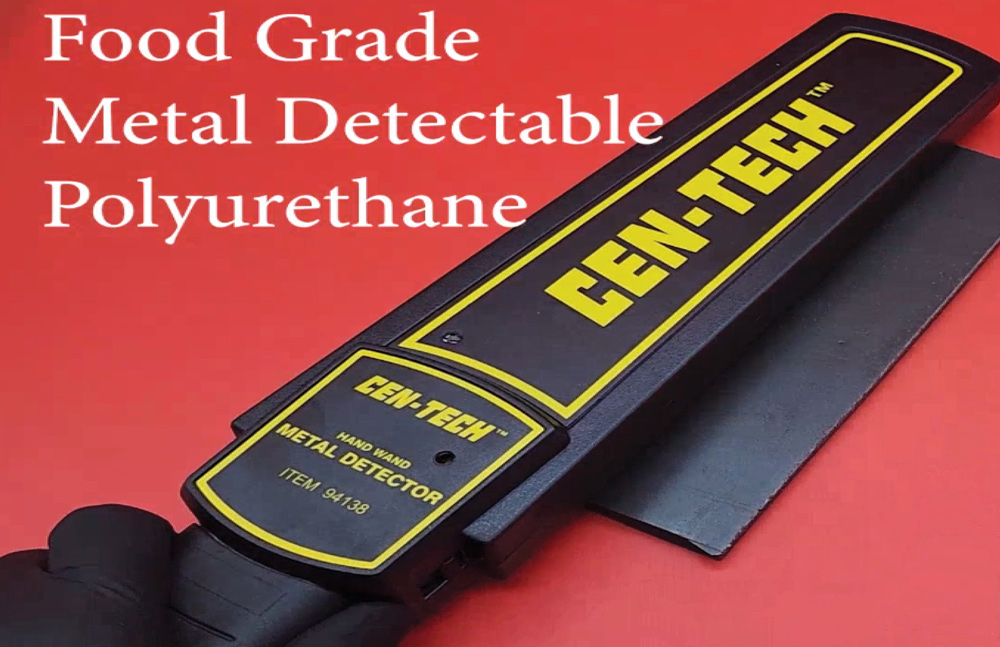SpecialFocus
food and beverage
he food processing industry has always used a myriad of food grade thermoplastics in order to satisfy complex application requirements, while remaining safe and detectable. Some plastics are used interchangeably, while others have special properties that cannot easily be replaced. What if many critical material properties could be fulfilled by a single material? Polyurethane elastomers are recently replacing traditional thermoplastics in food processing applications due to their low tooling costs and wide range of properties, ranging from rubber-like to plastic-like.
Traditional plastics have always been chosen based on one or two properties, at the expense of the other critical properties, leading to a shorter part life cycle, or an underwhelming application performance. A few of the key physical properties engineers must keep in mind while selecting materials for a food process are cost, detectability, chemical resistance, heat resistance and flammability, abrasion resistance, weight and rebound rate. There are plenty of other properties to consider, however these are just some of the complex application requirements a process, quality, and mechanical engineer might consider.
Until recently, the food industry has relied on a wide selection of materials, from UHMW and POM, to PP and nylon, each selected to maximize one or two properties, but forgoing other critical properties. One example of this is the commonly used ultra-high molecular weight polyethylene (UHMW-PE). UHMW-PE is a great material chosen for food processing due to its abrasion resistance, X-ray ability and its food safety capability. However, due to a low melt flow, the material often needs to be machined to create complex shapes. This increases labor costs and creates extra waste.
The ability to reduce routing steps marks one of the main reasons engineers are making the shift to polyurethane. The cast process that polyurethane demands allows for the production of a finished part, similar to injection molding, without the additional cost of complex tooling or expensive machinery. This means polyurethane is cost effective as you scale and the materials it’s replacing reflects this. Polyurethane elastomers are now replacing UHMW, HDPE, nylon, POM (acetal) and other similar thermoplastics in favor of the reduced tooling cost and versatile durometer range. Polyurethane elastomers offer a wide range of physical properties including high impact resistance, excellent rebound rate, good tear strength, good chemical resistance and high abrasion resistance.
Polyurethane elastomers can also be formulated to meet specific food grade requirements, such as FDA compliance and antimicrobial properties. Additives can reduce or increase abrasion resistances, are anti-static and offer all three major forms of detection; from color detection and X-ray, to metal detection. The material also allows for bonding to other materials such as metal, plastics or rubbers. This even allows companies to reclaim the metal bonded to polyurethane at the end of a part’s life cycle and rebond polyurethane to the same reclaimed metal.
The number one characteristic of polyurethane that is fueling this new wave of change is the material’s hardness range or durometer. Polyurethane elastomers belong to a category of synthetic rubber that exhibits plastic characteristics. This allows parts to range from being as soft as a gummy bear, to as hard as a bowling ball. This range allows for the fine tuning of many of the critical physical properties mentioned earlier. With this unique characteristic, the same mold can make parts of the same dimensions, but with very different physical properties. This is highly useful in not only production, but during the prototyping phase as well.

Metal Detectable Polyurethane Rubber used in food processing
Manufacturing processes have traditionally been limited by the material chosen for the application. Injection molding is the most common among these but comes at the expense of very high tooling costs and lead time. Other manufacturing processes, such as compression molding, may be used but has geometric limitations and generally produces a lower quality finish. This is the process used for UHMW components and other rubbers. Polyurethane uses a liquid cast process that produces engineering grade components with a low upfront tooling cost and shorter lead times.
In terms of heat resistance, polyurethane elastomers can be formulated to withstand high temperatures, making them suitable for use in applications such as ovens. This places polyurethane operating temperatures below engineer grade plastics such as PEEK, PEI or PPS, but above most POM, PP, PMMA, and on a similar level as nylon. Polyurethane can perform in consistent temperatures of 250 °F and up to 300 °F with specialized formulas. Additionally, they have low flammability and can meet various flammability standards.
Polyurethane does struggle to perform with applications experiencing high exposures to steam or select chemicals. However, most food grade wash down processes can expect to see hundreds or thousands of cycles before parts break down. Polyurethane parts can even be submerged under water for years and continue to perform. The versatility of polyurethane elastomers allows them to be used in a variety of food processing applications regardless of size or complexity, such as conveyor belts, sprockets, gears, dividers, seals, gaskets, rollers and more.
In summary, the use of polyurethane elastomers in the food processing industry offers a range of benefits over traditional thermoplastics, including cost-effectiveness, versatility and improved application performance. As a result, more engineers and manufacturers are turning to polyurethane elastomers as their material of choice for food processing applications in order to improve part life, reduce tooling costs and increase available detection methods.